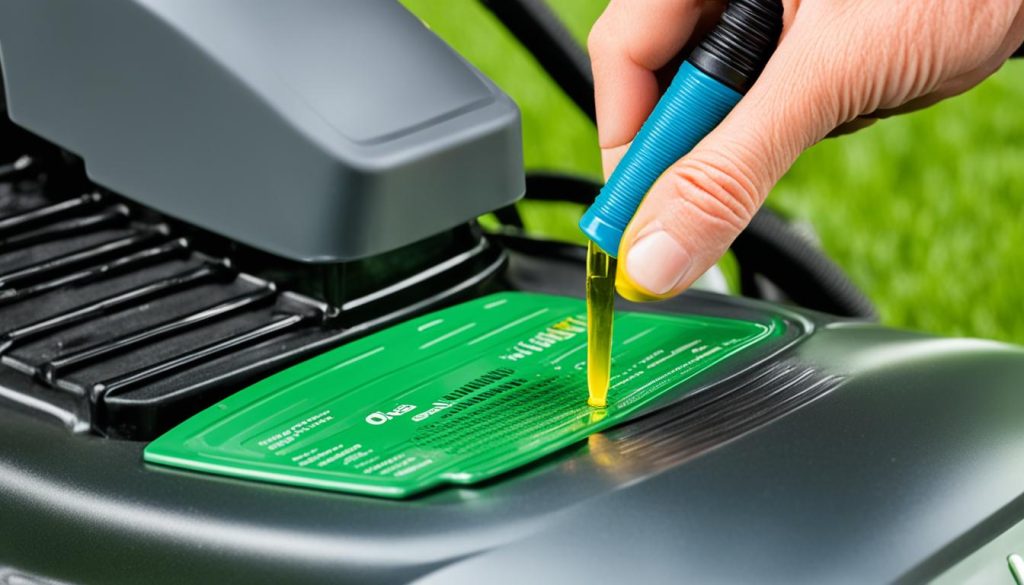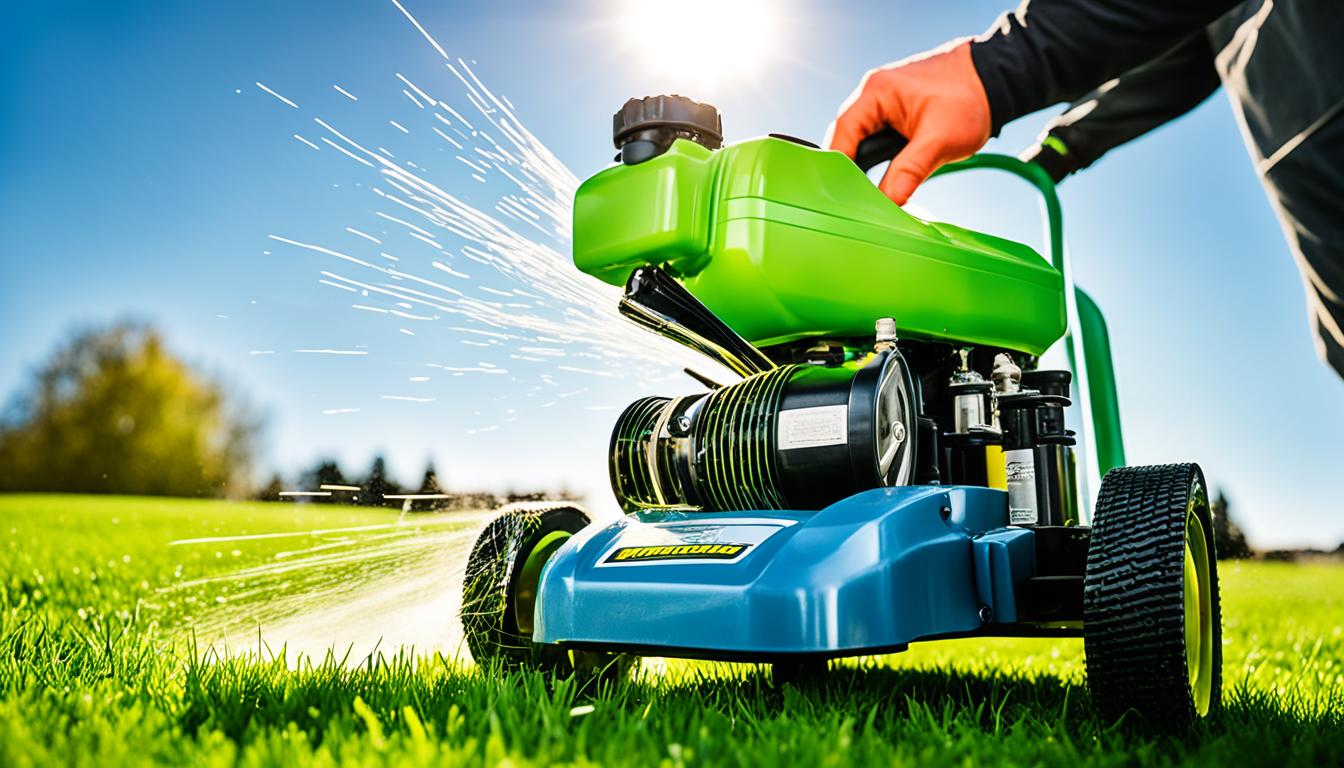Are you unsure about the right amount of oil to use in your lawn mower? It’s a common question that many people struggle with. Using the correct oil and filling it to the appropriate level is essential for the proper functioning and longevity of your mower’s engine. So, how much oil should you actually use?
There are a few factors to consider when determining the oil quantity for your lawn mower. The type of equipment, the engine specifications, and the temperature outside all play a role in selecting the correct oil and determining the appropriate oil capacity. Using the wrong oil or overfilling the engine can lead to poor performance and even damage to your mower.
In this article, we will dive deep into the topic of lawn mower oil and explore the recommended oil quantities for different types of mowers. We will debunk common misconceptions and provide you with the essential information you need to properly maintain your lawn mower.
Key Takeaways:
- Choosing the right oil and using the correct amount are crucial for the optimal performance of your lawn mower.
- Oil capacity varies depending on the type of mower, with walk-behind mowers typically holding around 15oz-18oz and riding mowers around 48oz-64oz.
- Using a high-quality detergent oil classified as “For Service SF, SG, SH, SJ” or higher is recommended for lawn mower engines.
- Regularly checking the oil level and performing oil changes at the recommended intervals are essential maintenance practices.
- Consulting your engine manual and following the manufacturer’s recommendations is crucial to ensure you are using the right oil and maintaining the correct oil level.
Choosing the Right Oil for Your Lawn Mower
When it comes to selecting the best oil for your lawn mower, it’s crucial to make an informed choice. Using the right oil not only ensures optimal performance but also helps extend the lifespan of your mower’s engine. There are several factors to consider when choosing the ideal oil for your lawn mower:
- Type of Oil: It is recommended to use a high-quality detergent oil classified as “For Service SF, SG, SH, SJ” or higher. Synthetic oils are also acceptable and offer excellent performance at all temperatures.
- Oil Change Intervals: The use of synthetic oil does not alter the required oil change intervals. It’s crucial to adhere to the manufacturer’s recommendations for regular oil changes to maintain the mower’s efficiency.
- Engine Manual: Consult your engine manual for specific oil recommendations and any unique requirements or restrictions.
One highly regarded option is the Briggs & Stratton Synthetic Oil, which is specifically designed to maximize performance and comply with warranty requirements. Using this recommended oil can help ensure optimal functionality and reliability for your lawn mower.
Before each use, it’s important to check the oil level in your lawn mower. This simple step ensures that the oil level is within the recommended range for proper lubrication. Ideally, the oil level should be between the full and add marks on the dipstick.
List of Recommended Lawn Mower Oils
| Oil Brand | Oil Type | Viscosity | Recommended Application |
|---|---|---|---|
| Briggs & Stratton | Synthetic Oil | 5W-30 or 15W-50 | For all temperature ranges |
| Castrol | Detergent Oil | SAE 30 | For warmer temperatures |
| Mobil 1 | Synthetic Oil | 5W-30 | For improved starting and less oil consumption |
Choosing the right oil for your lawn mower is essential for maintaining its efficiency and prolonging its lifespan. By using a high-quality oil and regularly checking the oil level, you can ensure smooth operation and reliable performance for years to come.
Lawn Mower Oil Capacity
When it comes to maintaining your lawn mower, understanding its oil capacity is essential. The oil capacity of a lawn mower varies depending on the type of mower you have. Walk-behind mowers typically have an oil capacity of around 15oz to 18oz, while riding mowers have a larger capacity ranging from 48oz to 64oz.
It is important to adhere to the recommended oil capacity and avoid overfilling the engine. Adding too much oil can lead to engine damage and affect the mower’s overall performance. Regularly checking the oil level and adding oil when necessary is crucial for proper operation.
To help visualize the oil capacities of different lawn mowers, refer to the table below:
| Mower Type | Oil Capacity (oz) |
|---|---|
| Walk-Behind Mower | 15-18 |
| Riding Mower | 48-64 |

Ensuring that your lawn mower has the correct amount of oil is crucial for its optimal performance and longevity. By following the manufacturer’s recommendations and regularly checking the oil level, you can keep your lawn mower running smoothly and efficiently.
Using Synthetic Oil for Your Lawn Mower
When it comes to using oil that provides superior protection and performance, synthetic oil for your lawn mower is an excellent choice. Briggs & Stratton, a renowned manufacturer of small engines, has updated their engine oil recommendations to include synthetic options. Synthetic oils like 5W30 or 15W50 can be utilized in all temperature ranges, making them versatile for various weather conditions.
Synthetic oil offers several advantages for your lawn mower. It provides improved starting, ensuring that your mower fires up easily even in cold weather. Additionally, synthetic oil reduces oil consumption, allowing your engine to run efficiently and making it more cost-effective in the long run.
Regardless of whether you choose to use synthetic oil or conventional oil, it’s crucial to adhere to the proper oil amount recommended for your lawn mower. Overfilling the engine with oil can lead to performance issues and potentially damage the engine, while insufficient oil can result in overheating and premature wear. Regular maintenance, such as checking and changing the oil, is essential for the optimal functioning of your lawn mower, regardless of the type of oil you choose.
To summarize:
- Synthetic oil, such as 5W30 or 15W50, can be used in all temperature ranges.
- It provides improved starting and reduces oil consumption.
- Stick to the proper oil amount recommended for your lawn mower.
- Perform regular maintenance, including checking and changing the oil.
By using synthetic oil and following proper maintenance procedures, you can ensure that your lawn mower operates at its best, providing reliable performance and extending its lifespan.
Checking Your Oil Level
To ensure the smooth operation of your lawn mower, it is crucial to regularly check the oil level. Follow these simple steps to accurately determine the oil level in your lawn mower:
- Park your lawn mower on a level surface to ensure an accurate reading.
- Locate the dipstick cap, usually located near the engine.
- Remove the dipstick cap and wipe the dipstick with a clean rag to remove any oil residue.
- Make sure that the teeth on the cap match the grooves on the dipstick tube before reinstalling the cap.
- Remove the cap again and carefully view the oil level towards the bottom of the dipstick blade.
The oil level should fall between the “full” and “add” marks on the dipstick. If the oil level is low, gradually add oil to avoid overfilling. Once you’ve added oil, allow enough time for it to settle before rechecking the oil level.

Proper Oil Level Maintenance
Maintaining the proper oil level in your lawn mower is vital for optimal performance and engine longevity. Insufficient oil can cause increased friction and wear, while overfilling can lead to excessive pressure and potential engine damage. Regularly checking and maintaining the oil level ensures that your lawn mower operates smoothly and efficiently.
Finding the Best Oil for Your Engine
When it comes to finding the best oil for your lawn mower engine, Briggs & Stratton has you covered. Their Oil Finder tool is designed to help you choose the right oil for your specific small engine, ensuring optimal performance and longevity. To get started, simply follow these steps:
- Visit the Briggs & Stratton website
- Access the Oil Finder tool
- Select your equipment type (e.g., push mower, riding mower)
- Choose your engine model or name
- Enter the outside temperature in your area
- Click “Find Oil”
Once you’ve completed these steps, the Briggs & Stratton Oil Finder will provide you with the recommended oil type and the proper amount to use for your specific engine. It’s important to note that consulting your engine operator’s manual for specific information is always recommended, as different engines may have unique requirements.
In addition to finding the best oil for your engine, it’s crucial to prioritize regular oil checks and changes as a part of your equipment’s maintenance routine. This ensures that your lawn mower continues to run smoothly and efficiently, while also extending the lifespan of the engine.
Remember, maintaining the right oil for your engine is just one piece of the puzzle. Other essential maintenance practices include keeping the air filter clean, inspecting and replacing spark plugs when necessary, and addressing any issues promptly to prevent further damage.
By following these recommendations and providing proper care to your lawn mower, you can enjoy years of reliable performance and a well-maintained lawn.
| Equipment Type | Engine Model | Recommended Oil | Proper Amount |
|---|---|---|---|
| Push Mower | Model A | SAE 30 | 20 oz (5/8 quart) |
| Push Mower | Model B | Synthetic SAE 5W-30 | 20 oz (5/8 quart) |
| Riding Mower | Model C | SAE 30 | 48 oz (1.42 quarts) |
| Riding Mower | Model D | Synthetic SAE 5W-30 | 48 oz (1.42 quarts) |
Changing the Oil in Your Lawn Mower
Regularly changing the oil in your lawn mower is crucial for maintaining optimal performance and extending the lifespan of the engine. The frequency of oil changes depends on the type of mower and how often it is used. Follow the guidelines below to ensure a proper oil change for your lawn mower.
Oil Change Recommendations
For new lawn mower engines, it is recommended to change the oil after the first five hours of use. This initial oil change helps remove any contaminants that may have accumulated during the break-in period.
For existing push mowers, it’s best to change the oil at least once a season or every 50 hours of running time. Seasonal oil changes help maintain the cleanliness and lubrication of the engine, ensuring smooth operation.
For existing riding mowers, it is advised to change the oil at least once a season or every 100 hours of running time. Riding mowers typically have larger oil capacities, and changing the oil regularly helps prevent engine damage and maintains optimal performance.
The Oil Change Process
Follow these steps to perform an oil change on your lawn mower:
- Ensure the mower is on a level surface and the engine is cool.
- Locate the oil drain plug at the base of the engine.
- Place a drain pan or container below the drain plug.
- Remove the drain plug and allow the used oil to fully drain into the container.
- Once all the oil has drained, replace the drain plug and tighten it securely.
- Locate the oil fill cap or dipstick tube.
- Remove the cap or dipstick to access the oil fill opening.
- Pour the recommended amount of oil into the engine. Refer to your owner’s manual for the proper oil capacity.
- Replace the oil fill cap or dipstick.
Proper Oil Amount for Your Lawn Mower
It is crucial to use the proper amount of oil when performing an oil change in your lawn mower. Using too little oil can result in inadequate lubrication of the engine, while using too much can cause excess pressure and potential damage. Refer to your owner’s manual for the specific oil capacity of your lawn mower. Different types of mowers can have varying oil capacities depending on the engine size and design.
Lawn Mower Oil Capacities
| Lawn Mower Type | Oil Capacity |
|---|---|
| Push Mower | Approximately 15oz – 18oz |
| Riding Mower | Approximately 48oz – 64oz |
Ensure that you pour the correct amount of oil into the engine during the oil change process. Overfilling or underfilling the engine can lead to performance issues and potential damage.
Performing regular oil changes and using the proper oil amount for your lawn mower is essential for maintaining its longevity and enjoying reliable performance for years to come.
How to Change the Oil in a Push Mower
To change the oil in a push mower, follow these simple steps:
- Seal the gas tank by removing the gas cap and covering the opening with a plastic bag.
- Remove the dipstick from the oil filler tube. This will allow the oil to drain more efficiently.
- Tip the mower so that the oil can drain out. Make sure to position a drainage pan or container under the mower to catch the used oil.
- Pour the used oil into a container for recycling. It is important to dispose of used oil responsibly.
- Refill the engine with clean oil. Be careful not to overfill it. The oil level should be between the minimum and maximum marks on the dipstick.
- Insert the dipstick back into the oil filler tube and secure it.
- Check the oil level again to ensure it is within the recommended range. If necessary, add more oil until it reaches the desired level.
The oil capacity for most push mower engines is around 20 oz (5/8 quart). However, it is always best to refer to the manufacturer’s guidelines or consult the owner’s manual for the specific oil capacity of your mower’s engine.
Changing the oil in your push mower regularly is essential for maintaining optimal performance and extending the lifespan of the engine. By following these steps, you can ensure that your push mower stays in top condition and continues to provide you with a well-manicured lawn.
How to Change the Oil in a Riding Lawn Mower
Changing the oil in a riding lawn mower is an important maintenance task that helps maintain optimal performance and extend the lifespan of the engine. While the process is similar to changing oil in a push mower, it’s crucial to refer to the owner’s manual or online tutorials for specific instructions and the location of necessary parts. Here is a step-by-step guide to changing the oil in a riding lawn mower:
- Prepare the mower: Before starting the oil change process, ensure the riding lawn mower is on level ground and that the engine is cool to avoid any safety hazards.
- Locate the oil drain plug: Refer to the owner’s manual or online resources to find the location of the oil drain plug. This is typically located on the lower side of the engine.
- Seal the gas tank: To prevent any spills or contamination, seal the gas tank by either running the mower until the fuel is depleted or using a gas shutoff valve if equipped.
- Position an oil pan: Place an oil pan or container beneath the oil drain plug to catch the old oil.
- Drain the old oil: With a suitable wrench or socket, carefully unscrew the oil drain plug and allow the old oil to drain fully into the oil pan. It may take a few minutes for all the oil to drain out.
- Replace the oil filter (if applicable): Some riding lawn mowers have oil filters that need to be replaced during the oil change process. Refer to the owner’s manual for guidance on replacing the oil filter.
- Install the oil drain plug: Once all the old oil has drained, clean the oil drain plug and reinstall it securely. Ensure it is tightened to the manufacturer’s specifications.
- Refill with clean oil: Refer to the owner’s manual for the recommended oil type and capacity for your specific riding lawn mower. Using a funnel, slowly pour clean oil into the oil fill port, taking care not to overfill. Check the oil level using the dipstick.
- Dispose of the old oil: Properly dispose of the old oil by recycling it at a local oil recycling center or facility. Do not pour it down the drain or discard it with regular household waste.
Regularly changing the oil in your riding lawn mower, following the manufacturer’s recommendations, is crucial for maintaining the engine’s performance and longevity. By properly maintaining the oil level and capacity, you can ensure that your riding lawn mower operates smoothly and efficiently.
Conclusion
Properly maintaining the oil level and capacity of your lawn mower is crucial for its optimal performance and longevity. The amount of oil required depends on the type of mower and its specific oil capacity. Walk-behind mowers generally hold around 15oz-18oz of oil, while riding mowers have a larger capacity of 48oz-64oz.
It is essential to follow the manufacturer’s recommendations regarding the type of oil to use and regularly check the oil level. Maintaining the proper oil level ensures that the engine is adequately lubricated and protected from excessive wear. Additionally, changing the oil at the recommended intervals and using high-quality detergent oil helps to keep your lawn mower running smoothly and efficiently.
By adhering to these maintenance practices, you can extend the lifespan of your lawn mower’s engine and avoid costly repairs. Always consult your owner’s manual for specific instructions and recommendations pertaining to your mower. Keeping your lawn mower well-maintained will allow you to enjoy a beautifully manicured lawn for years to come.





